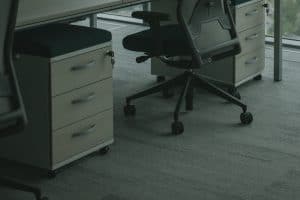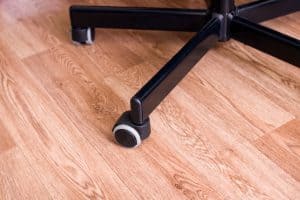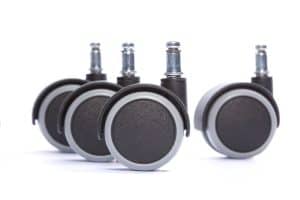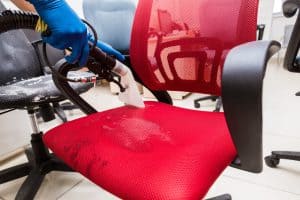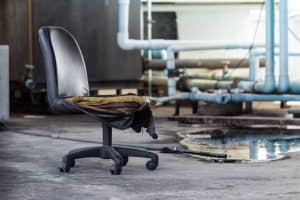Office chairs with rotating wheels are very practical because you can easily move around your desk or quickly slide to your colleagues’ desks to consult with them. However, this flexibility in moving around can quickly disappear if you don’t clean the office chair wheels.
Most people don’t really realize that office chair wheels need to be regularly cleaned until they’re actually stuck and moving is restricted or not smooth anymore. If that’s the case, don’t worry. There are many different methods for cleaning office chair wheels, and we’re going to explain all of them. Whether you have debris, hair, or chewing gum stuck in your wheels, we got your back.
But, before we dive into the heart of the matter, let’s briefly explain the different types of office chair wheels as the model can sometimes affect how much and where they accumulate debris. Plus, just in case your wheels are damaged and can’t be saved, you need to find the right replacement. Let’s go.
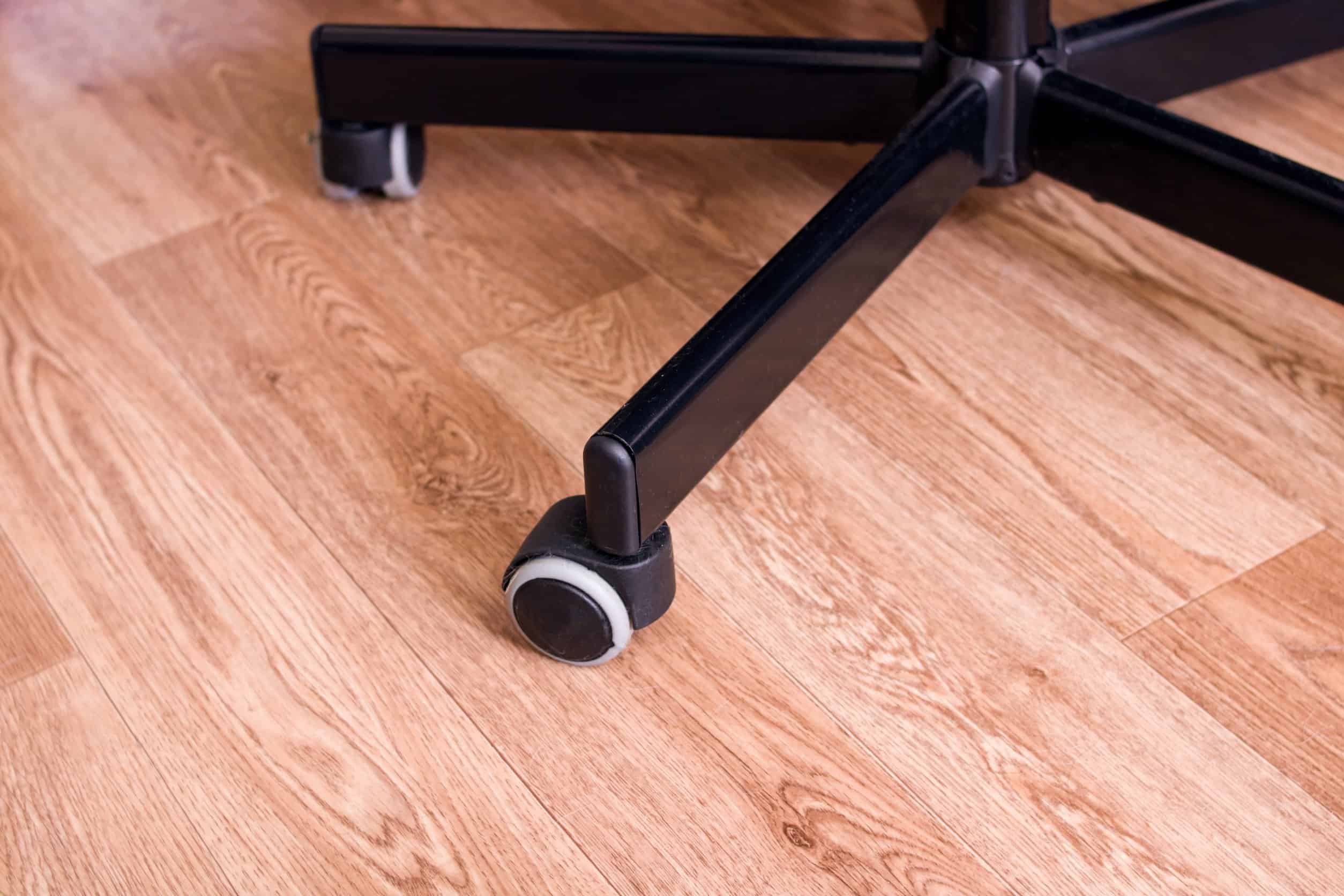
Types of Caster Wheels
The wheels on your office chair are called casters because they slide in all directions. The caster is more than just a wheel – it’s an assembly of two parts: the wheel and the rotating bracket, also called fork or yoke. Thanks to this bracket the wheel can slide in all directions – not just back and forward. However, it’s also because of this bracket that the office chair wheels are so prone to accumulating hair and debris. As the wheel turns, the hair and debris get stuck between the wheel and the bracket. The wheel keeps turning, but the hair and debris stay in this tiny gap. Once enough dirt has been accumulated it starts pressing on the wheel, preventing it from moving.
Some caster wheels accumulate more dirt than others because of their design. Fortunately, all caster wheels are removable (with some rare exceptions) and you can take them out to thoroughly clean them. There are two main types of caster wheels – soft and hard.
Hard Caster Wheels
Hard caster wheels are typically the standard for most office chairs. They’re made for carpeted floors and might move unexpectedly or even damage hard, smooth floors. In fact, the damage is in both directions, and using hard caster wheels on hard floors will affect the life cycle of your chair.
Hard castors are made of plastic and are less prone to accumulating hair and debris – but they are not resilient.
Soft Caster Wheels
Soft caster wheels are a little more expensive or you’ll need to pay extra depending on the chair model. However, they’re vital if you’re using your chair on hard floors without a protective mat.
Since soft casters are made from rubber or polyurethane, they won’t work on carpets or rugs. It would be almost impossible to slide them on such soft and textured surfaces. Plus, hair and other debris stick to rubber much more easily than plastic. So, if your office chair wheels are accumulating dirt very frequently, check to see if you’re using them on a suitable surface.
Another thing to remember is that suitable cleaning methods for hard and soft casters might not overlap completely. We’ll add disclaimers when we explain how to clean your office chair wheels, but you should know what type of casters you have to avoid damaging them while cleaning.
Now that we’ve cleared that up, let’s get right to it.
Cleaning Office Chair Wheels
Regardless of what you do, due to their design and the fact that they’re casters, office chair wheels will eventually accumulate dirt and build up debris. Here’s what you need to do.
Supplies
Depending on what you’re cleaning (hair vs. chewing gum), the type of caster wheel you have, and the method you choose, you’ll need different cleaning supplies. Nonetheless, here’s a summary of everything we recommend in this article.
- nose pliers (for dismantling the wheels – optional; first method);
- small vacuum (first method);
- scrub brush (for hard casters only; first method);
- dish soap;
- wet wipes or wet towel (for soft casters; first method);
- tweezers (second method);
- nail clipper with a bottle opener (second method);
- flame torch or lighter (third method);
- drain cleaner product;
- duct tape (fourth method);
Preparing The Chair
Before you start cleaning, you must prepare the chair, which usually consists of covering your floor, removing the casters, and/or flipping your whole chair horizontally on the ground.
First things first, take a plastic sheet or cardboard and place it under the chair in the area where you’ll be working. Since some of the cleaning methods require using flame torches or lubricants such as the WD40, ensuring the floor underneath is protected is essential.
Removing and Dismantling the Wheels
Second, you need to decide how you’re going to work. Flip your chair horizontally on the ground to get the wheels in an elevated and exposed position. Keep in mind that the wheels should lay on the protection sheet you have placed.
Now, you can either remove the wheels and work on them one-by-one, or rotate the chair while working on the wheels still attached. The former is a much better approach and one that we recommend. Removing the wheels makes cleaning much easier, plus it minimizes the chances of accidentally damaging the chair itself. However, if you can’t remove the wheels or your chair has non-removable wheels, you can also work with the chair flipped horizontally. In this case, you need to be a lot more gentle and careful.
If you remove the wheels, you can go one step further and dismantle them completely. This is a little risky as you can damage the structure and mechanism of the wheels, but cleaning is a breeze, and putting them back together is pretty straightforward. Here’s a Youtube video demonstrating the process of dismantling the wheels; you can watch and decide for yourself if that’s something you want to try. The only thing you’ll need to dismantle the wheels is the pliers.
Once you’re happy with your setup, you can start the cleaning process.
Cleaning Methods
We’ll take a look at five different cleaning methods that you can use to remove entangled hair, dirt, other debris, and chewing gums.
-
Traditional Old-School Method
Whether we’re talking about dirt, debris, or hair, the standard way to remove it is with your hand and pliers to help you out with the more entangled bits. If you don’t have nose pliers, you can use kitchen tweezers or other long and thin sticks to pull the hair and debris out of the wheel.
However, if you choose not to dismantle the wheels, be careful not to damage the wheel in the process, especially if you have soft caster wheels.
Gently pull the hair and debris with the pliers while turning the wheel toward you. Once you’re satisfied with the inside of the wheels, use a small vacuum to suck in any remaining pieces of debris and dirt that you might have missed.
Finally, take a scrub brush and thoroughly clean the outside of the wheels, especially where the wheels touch the floor. You can also use dish soap and water to soak the scrub brush. However, cleaning the outside with a scrub brush is only for hard caster wheels. Do not use a hard scrub on soft casters. Instead, use a wet wipe with disinfectant or a wet cloth.
Let the wheels dry and put them back together (if you have dismantled them).
-
The Tweezer and Nail Clipper Method for Removing Hair
You can also use tweezers and a nail cutter with a bottle opener for handling a large build-up of extremely tangled hair. Also, this method is probably more efficient than the one we’ve described above if you do not want to dismantle the office wheel.
So, take the wheel and pluck as much hair as possible with the tweezers. It’s helpful to try turning the wheel a little forward or backward to help loosen the hairs stuck while you’re plucking them.
If you can, cut the hairs with the nail clipper and rotate the wheel again, then pluck some more. This can help disentangle some of the hair. But, if it doesn’t work, use the bottle opener in the nail clipper to hook some of the entangled hair and pull it as hard as you can. But, be careful not to break the wheels.
If you feel like there’s too much hair and it’s too entangled, keep reading, as the third solution will burn everything away.
-
The Flame Torch for Removing Hair
If you do not want to dismantle the office chair wheels, but there’s a lot of hair stuck in them, you might use a flame torch to burn the hair away. This is probably a much riskier method than simply dismantling the chair wheels when it comes to damaging the wheels, but a lot of people use it. In fact, there are many different variations to this method including a lighter, blowtorch, and other heat sources.
First, let us say that you should not attempt this if you have soft caster wheels – you’ll damage them. And, second, you probably should not attempt this at all, but it’s a way to get the hair out of your office chair wheels, and if you’re extremely careful, it might just work.
So, take a light to medium flame torch or a lighter, and heat the hair with short bursts of flame (one second at a time). Do not keep the flame for more than a second or two on the wheels as it will damage them (melt them), and you might burn your chair.
Once you start smelling the burning hair, it means that it’s working, and you should repeat the process as you rotate the wheel until the hair is gone.
If you’re using fire, always do this outdoors – it’s safer and your house won’t smell like burned hair afterward.
Our Recommendation
Since there’s a higher risk of damage or an accident when using fire, we recommend an alternative that works just as well – a drain cleaner! Products like DRANO dissolve hair and other debris but are not strong enough to damage the plastic.
So, fill a bowl with water and pour DRANO or other drain cleaner products (check if it’s safe for plastics). Submerge the office chair wheels. Leave them for a couple of hours and then rinse them with soapy water and clean them thoroughly with a disinfectant. The hair should be all gone.
Do not use drain cleaner on soft caster wheels.
-
The Duct Tape for Removing Dirt and Debris
Sometimes hair is not the problem, but dirt and debris are stuck between the wheel and the bracket, causing friction when you move the chair. If that’s the case, then you can try to remove the dirt and debris with duct tape. Here’s how to do it.
Cut a piece of duct tape, and with the sticky part on the outside, wrap it around pliers, tweezers, or anything that can fit inside the wheels. Then, stick it inside the wheels between the wheel and the brack to remove dirt and debris. Usually, small pieces of dirt will stick to the tape, and you’ll be able to remove them easily.
However, if you feel like that’s not enough, you can always use the tweezers and nose pliers to poke and prod around some more.
-
The WD40 and GOO GONE for Removing a Chewing Gum
Last but not least, you can use products like WD40 and GOO GONE to remove stickier things like chewing gum, which is a nightmare if it gets stuck in your office chair wheel.
The GOO GONE spray makes the gum less sticky and easier to peel off. So, all you need to do is spray it on the wheel where the gum is and wait for a few minutes, then try to remove it.
You can also try the same thing with lubricants such as the WD40. They’ll make the chewing gum slide off the wheels when you pull it after 5-6 minutes.
However, if there’s too much gum, the best thing to do would be to dismantle the wheel, as we described earlier in the article.
Conclusion
Cleaning office chair wheels is annoying and time-consuming, but it’s not hard. Check them for hair and debris and clean them when needed to prevent dirt and debris from building up over time.
However, if you find yourself with an office chair that doesn’t slide smoothly anymore for whatever reason, follow our advice to safely remove the wheels, examine them, dismantle them if necessary, and clean them thoroughly.
